battery YAMAHA WR 250F 2003 Owners Manual
[x] Cancel search | Manufacturer: YAMAHA, Model Year: 2003, Model line: WR 250F, Model: YAMAHA WR 250F 2003Pages: 860, PDF Size: 35.16 MB
Page 52 of 860

1 - 27
GEN
INFO
EC150000
CONTROL FUNCTIONS
MAIN SWITCH
Functions of the respective switch
positions are as follows:
ON:
The engine can be started only at
this position.
OFF:
All electrical circuits are switched off.
Main switch indicator light
The main switch
1 is equipped with
an indicator light
2 to avoid forget-
ting to turn it off. This light functions
as follows.
It lights up with the main switch
“ON”.
It goes out when the engine
increases its speed after being
started.
It lights up again when the engine
is stopped.
NOTE:If the indicator light will not light up
with the main switch “ON”, it shows a
lack of the battery voltage. Recharge
the battery. If the engine is kick
started, turn off the light switch.
ENGINE STOP SWITCH
The engine stop switch
1 is located
on the left handlebar. Continue push-
ing the engine stop switch till the
engine comes to a stop.
START SWITCH
The start switch
1 is located on the
right handlebar. Push this switch to
crank the engine with the starter.
EC152000CLUTCH LEVER
The clutch lever
1 is located on the
left handlebar; it disengages or
engages the clutch. Pull the clutch
lever to the handlebar to disengage
the clutch, and release the lever to
engage the clutch. The lever should
be pulled rapidly and released slowly
for smooth starts.
FONCTIONS DES
COMMANDES
COMMUTATEUR PRINCIPAL
Les fonctions des différentes positions
du commutateur sont les suivantes:
ON:
Le moteur ne peut être mis en marche
que lorsque le commutateur est à cette
position.
OFF:
Tous les circuits électriques sont coupés.
Témoin de commutateur principal
Le commutateur principal 1 est muni
d’un témoin 2 rappelant qu’il est activé.
Ce témoin fonctionne de la façon sui-
vante.
Il s’allume lorsque le commutateur
principal est en position “ON” .
Il s’éteint lorsque la vitesse du moteur
augmente après le démarrage.
Il s’allume lorsque le moteur est
arrêté.
N.B.:
Si le témoin ne s’allume pas lorsque le
commutateur principal est en position de
“ON”, c’est que la batterie est faible et
doit être rechargée. Si la pédale est utili-
sée pour mettre le moteur en marche, il
faut éteindre le témoin.
COUPE-CIRCUIT DU MOTEUR
Le coupe-circuit du moteur 1 est situé à
la poignée gauche. Appuyer de façon
continue sur le coupe-circuit du moteur
jusqu’à ce que le moteur s’arrête.
COMMUTATEUR DE
DEMARRAGE
Le commutateur de démarrage 1 se
trouve sur la manette droite du guidon.
Appuyer sur ce commutateur pour mettre
le moteur en marche avec le démarreur.
LEVIER D’EMBRAYAGE
Le levier d’embrayage 1 est situé à la
poignée gauche et permet d’embrayer ou
de débrayer. Tirer le levier d’embrayage
vers le guidon pour débrayer et relâcher
le levier pour embrayer. Pour des démar-
rages doux, le levier doit être tiré rapide-
ment et relâché lentement.
CONTROL FUNCTIONS
FONCTIONS DES COMMANDES
Page 64 of 860
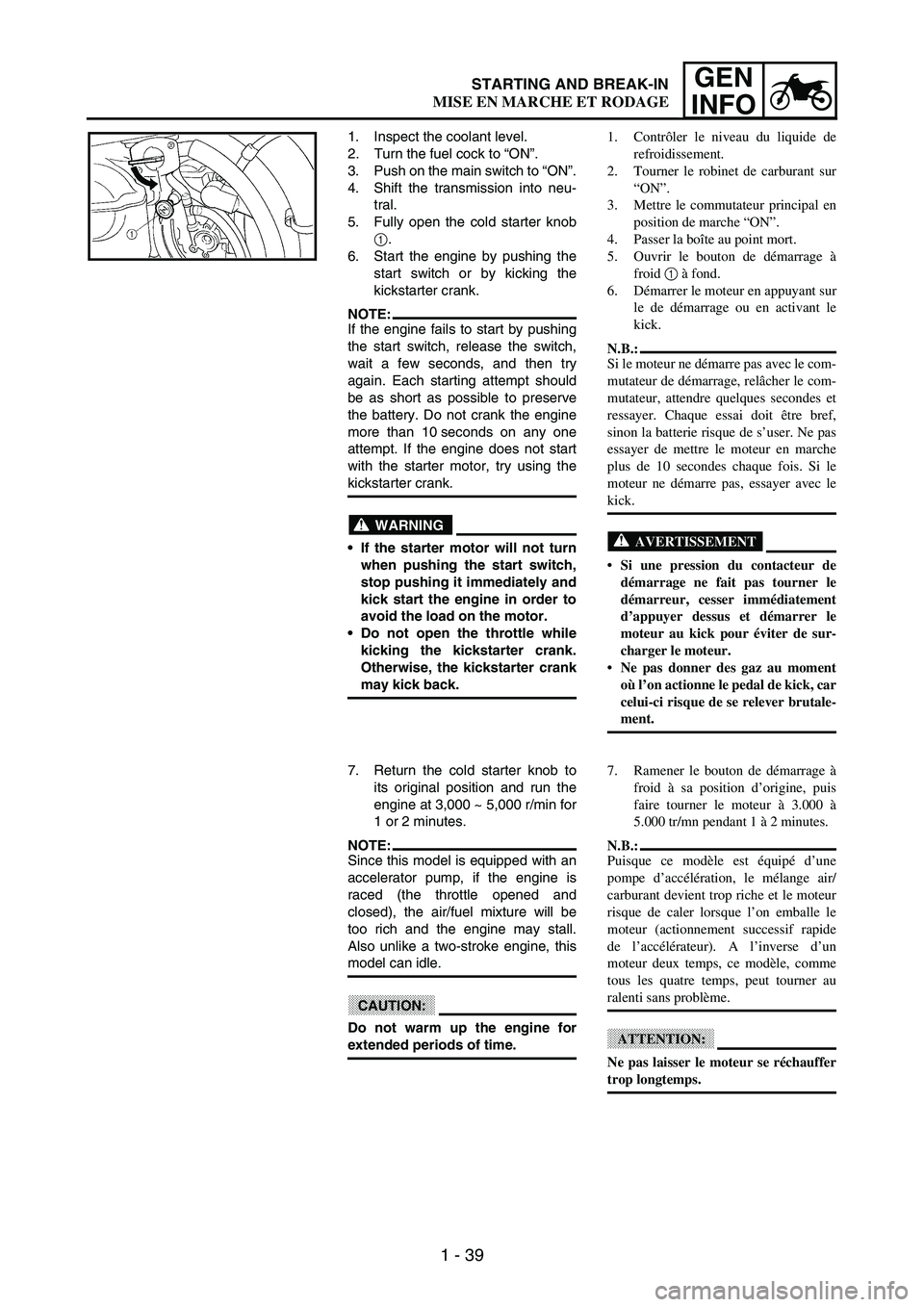
1 - 39
GEN
INFO
1. Inspect the coolant level.
2. Turn the fuel cock to “ON”.
3. Push on the main switch to “ON”.
4. Shift the transmission into neu-
tral.
5. Fully open the cold starter knob
1.
6. Start the engine by pushing the
start switch or by kicking the
kickstarter crank.
NOTE:If the engine fails to start by pushing
the start switch, release the switch,
wait a few seconds, and then try
again. Each starting attempt should
be as short as possible to preserve
the battery. Do not crank the engine
more than 10 seconds on any one
attempt. If the engine does not start
with the starter motor, try using the
kickstarter crank.
WARNING
If the starter motor will not turn
when pushing the start switch,
stop pushing it immediately and
kick start the engine in order to
avoid the load on the motor.
Do not open the throttle while
kicking the kickstarter crank.
Otherwise, the kickstarter crank
may kick back.
7. Return the cold starter knob to
its original position and run the
engine at 3,000 ~ 5,000 r/min for
1 or 2 minutes.
NOTE:Since this model is equipped with an
accelerator pump, if the engine is
raced (the throttle opened and
closed), the air/fuel mixture will be
too rich and the engine may stall.
Also unlike a two-stroke engine, this
model can idle.
CAUTION:
Do not warm up the engine for
extended periods of time.1. Contrôler le niveau du liquide de
refroidissement.
2. Tourner le robinet de carburant sur
“ON”.
3. Mettre le commutateur principal en
position de marche “ON”.
4. Passer la boîte au point mort.
5. Ouvrir le bouton de démarrage à
froid 1 à fond.
6. Démarrer le moteur en appuyant sur
le de démarrage ou en activant le
kick.
N.B.:
Si le moteur ne démarre pas avec le com-
mutateur de démarrage, relâcher le com-
mutateur, attendre quelques secondes et
ressayer. Chaque essai doit être bref,
sinon la batterie risque de s’user. Ne pas
essayer de mettre le moteur en marche
plus de 10 secondes chaque fois. Si le
moteur ne démarre pas, essayer avec le
kick.
AVERTISSEMENT
Si une pression du contacteur de
démarrage ne fait pas tourner le
démarreur, cesser immédiatement
d’appuyer dessus et démarrer le
moteur au kick pour éviter de sur-
charger le moteur.
Ne pas donner des gaz au moment
où l’on actionne le pedal de kick, car
celui-ci risque de se relever brutale-
ment.
7. Ramener le bouton de démarrage à
froid à sa position d’origine, puis
faire tourner le moteur à 3.000 à
5.000 tr/mn pendant 1 à 2 minutes.
N.B.:
Puisque ce modèle est équipé d’une
pompe d’accélération, le mélange air/
carburant devient trop riche et le moteur
risque de caler lorsque l’on emballe le
moteur (actionnement successif rapide
de l’accélérateur). A l’inverse d’un
moteur deux temps, ce modèle, comme
tous les quatre temps, peut tourner au
ralenti sans problème.
ATTENTION:
Ne pas laisser le moteur se réchauffer
trop longtemps.
STARTING AND BREAK-IN
MISE EN MARCHE ET RODAGE
Page 82 of 860
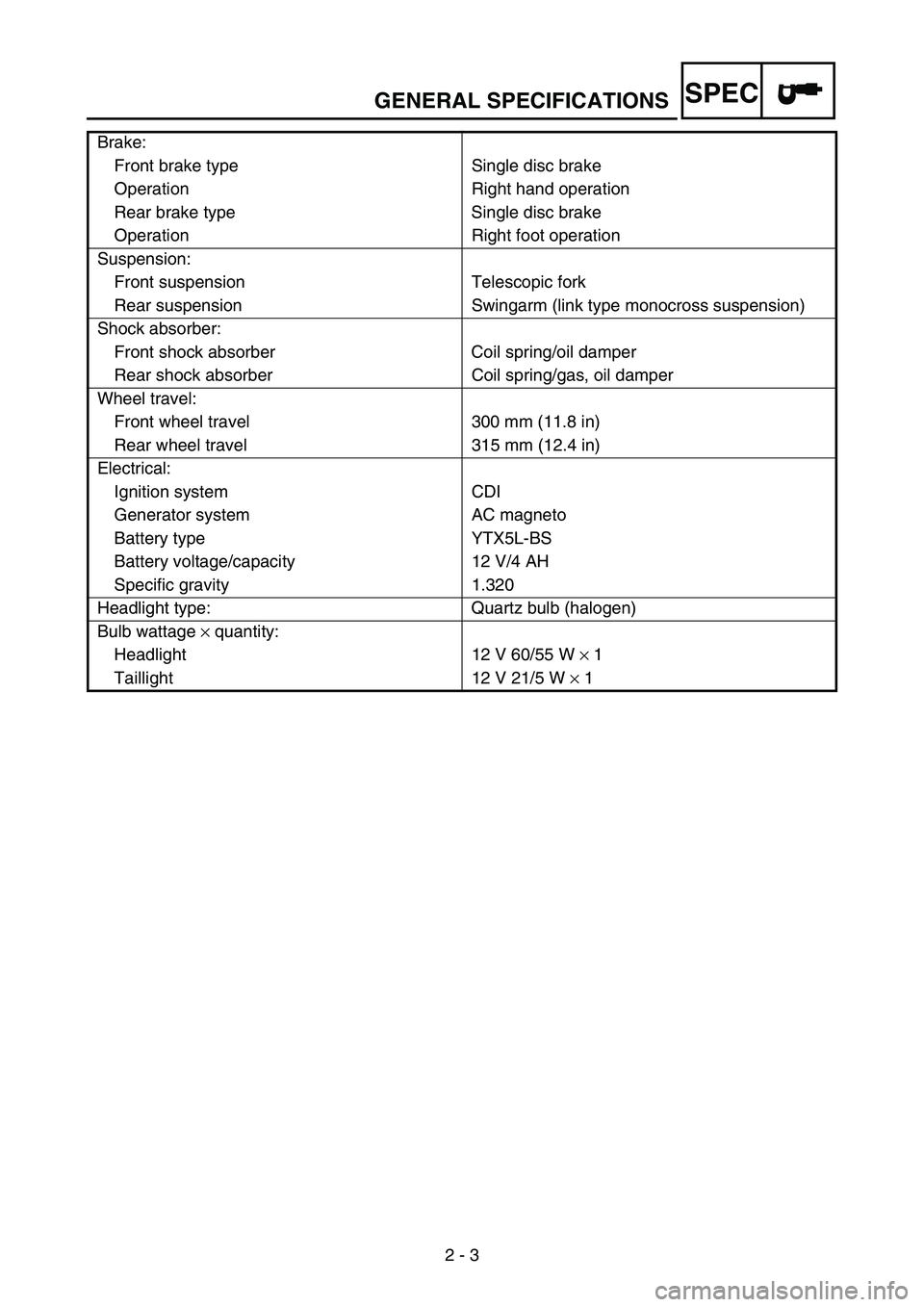
GENERAL SPECIFICATIONS
2 - 3
SPEC
Brake:
Front brake type Single disc brake
Operation Right hand operation
Rear brake type Single disc brake
Operation Right foot operation
Suspension:
Front suspension Telescopic fork
Rear suspension Swingarm (link type monocross suspension)
Shock absorber:
Front shock absorber Coil spring/oil damper
Rear shock absorber Coil spring/gas, oil damper
Wheel travel:
Front wheel travel 300 mm (11.8 in)
Rear wheel travel 315 mm (12.4 in)
Electrical:
Ignition system CDI
Generator system AC magneto
Battery type YTX5L-BS
Battery voltage/capacity 12 V/4 AH
Specific gravity 1.320
Headlight type: Quartz bulb (halogen)
Bulb wattage × quantity:
Headlight 12 V 60/55 W × 1
Taillight 12 V 21/5 W × 1
Page 176 of 860
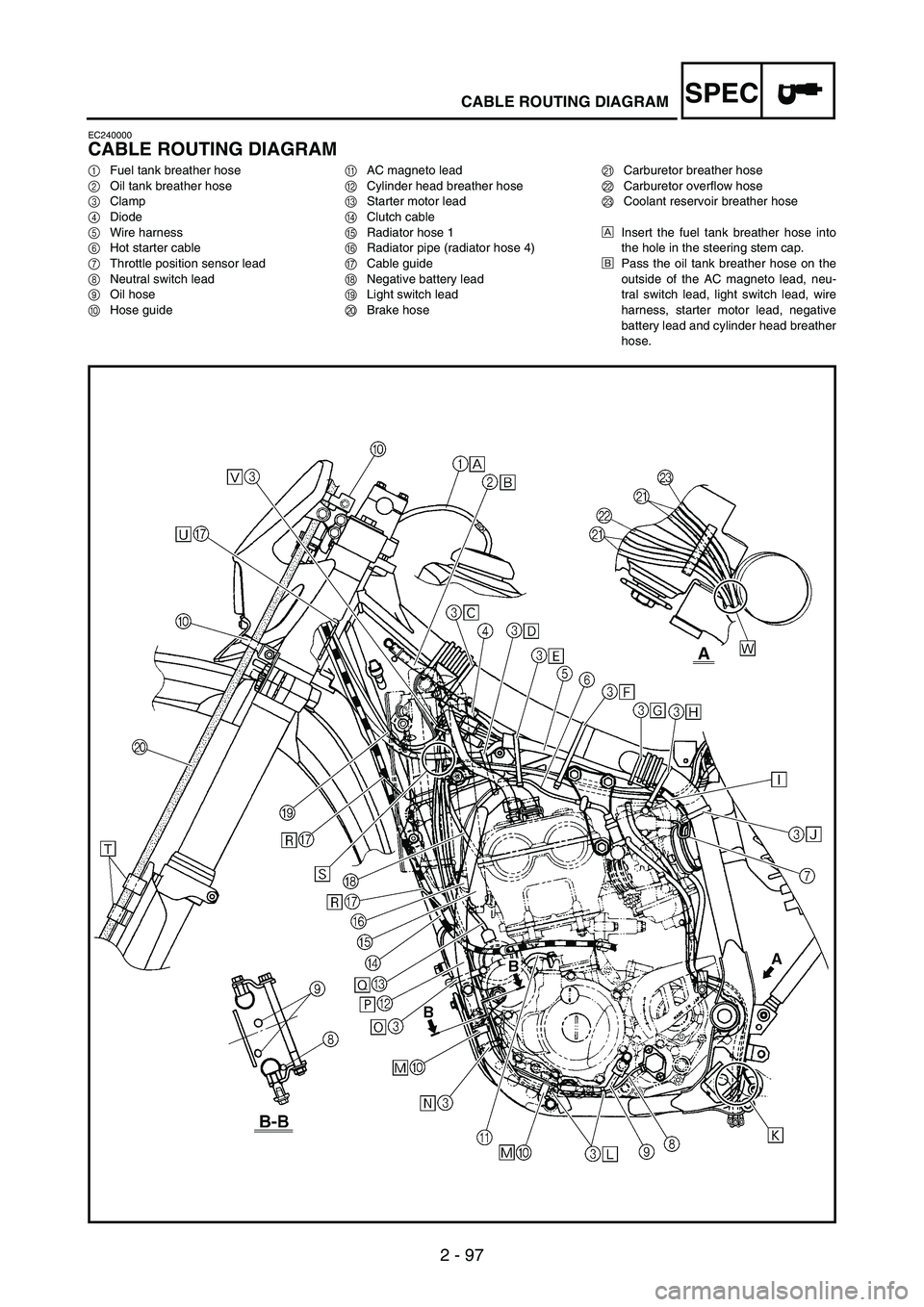
SPEC
2 - 97
CABLE ROUTING DIAGRAM
EC240000
CABLE ROUTING DIAGRAM
1Fuel tank breather hose
2Oil tank breather hose
3Clamp
4Diode
5Wire harness
6Hot starter cable
7Throttle position sensor lead
8Neutral switch lead
9Oil hose
0Hose guideAAC magneto lead
BCylinder head breather hose
CStarter motor lead
DClutch cable
ERadiator hose 1
FRadiator pipe (radiator hose 4)
GCable guide
HNegative battery lead
ILight switch lead
JBrake hoseKCarburetor breather hose
LCarburetor overflow hose
MCoolant reservoir breather hose
ÈInsert the fuel tank breather hose into
the hole in the steering stem cap.
ÉPass the oil tank breather hose on the
outside of the AC magneto lead, neu-
tral switch lead, light switch lead, wire
harness, starter motor lead, negative
battery lead and cylinder head breather
hose.
Page 178 of 860
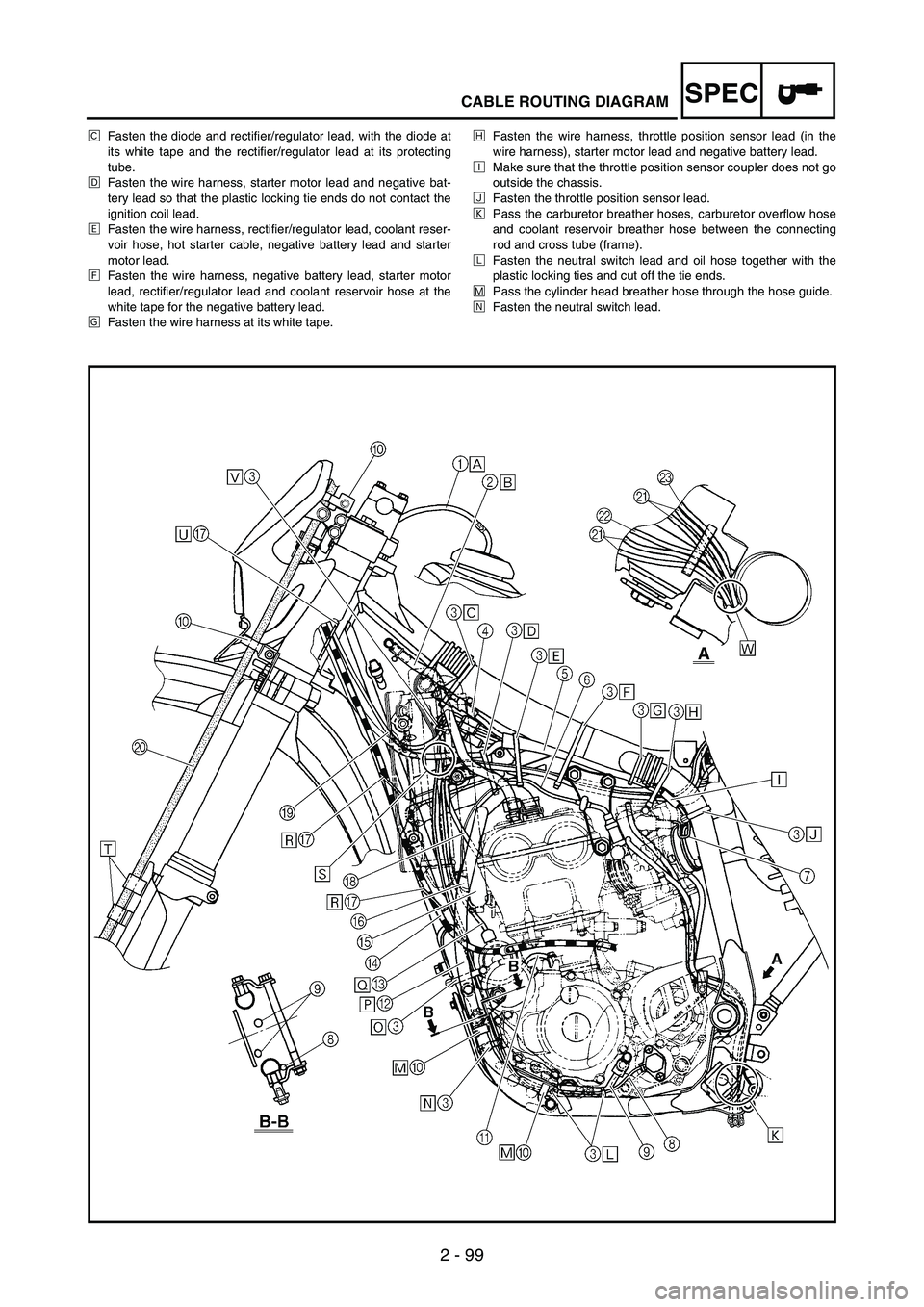
SPEC
2 - 99
CABLE ROUTING DIAGRAM
ÊFasten the diode and rectifier/regulator lead, with the diode at
its white tape and the rectifier/regulator lead at its protecting
tube.
ËFasten the wire harness, starter motor lead and negative bat-
tery lead so that the plastic locking tie ends do not contact the
ignition coil lead.
ÌFasten the wire harness, rectifier/regulator lead, coolant reser-
voir hose, hot starter cable, negative battery lead and starter
motor lead.
ÍFasten the wire harness, negative battery lead, starter motor
lead, rectifier/regulator lead and coolant reservoir hose at the
white tape for the negative battery lead.
ÎFasten the wire harness at its white tape.ÏFasten the wire harness, throttle position sensor lead (in the
wire harness), starter motor lead and negative battery lead.
ÐMake sure that the throttle position sensor coupler does not go
outside the chassis.
ÑFasten the throttle position sensor lead.
ÒPass the carburetor breather hoses, carburetor overflow hose
and coolant reservoir breather hose between the connecting
rod and cross tube (frame).
ÓFasten the neutral switch lead and oil hose together with the
plastic locking ties and cut off the tie ends.
ÔPass the cylinder head breather hose through the hose guide.
ÕFasten the neutral switch lead.
Page 188 of 860
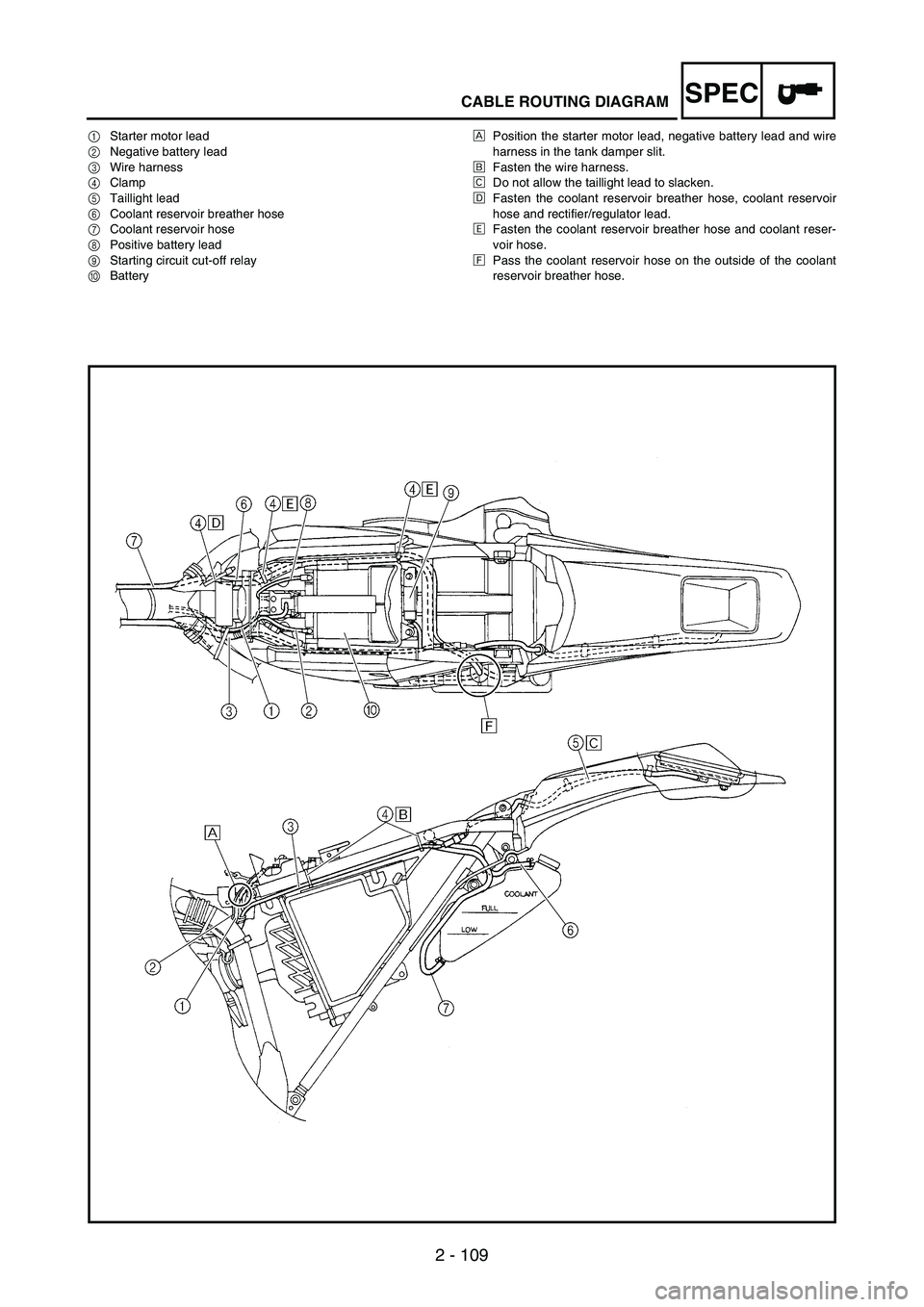
SPEC
2 - 109
CABLE ROUTING DIAGRAM
1Starter motor lead
2Negative battery lead
3Wire harness
4Clamp
5Taillight lead
6Coolant reservoir breather hose
7Coolant reservoir hose
8Positive battery lead
9Starting circuit cut-off relay
0BatteryÈPosition the starter motor lead, negative battery lead and wire
harness in the tank damper slit.
ÉFasten the wire harness.
ÊDo not allow the taillight lead to slacken.
ËFasten the coolant reservoir breather hose, coolant reservoir
hose and rectifier/regulator lead.
ÌFasten the coolant reservoir breather hose and coolant reser-
voir hose.
ÍPass the coolant reservoir hose on the outside of the coolant
reservoir breather hose.
Page 194 of 860
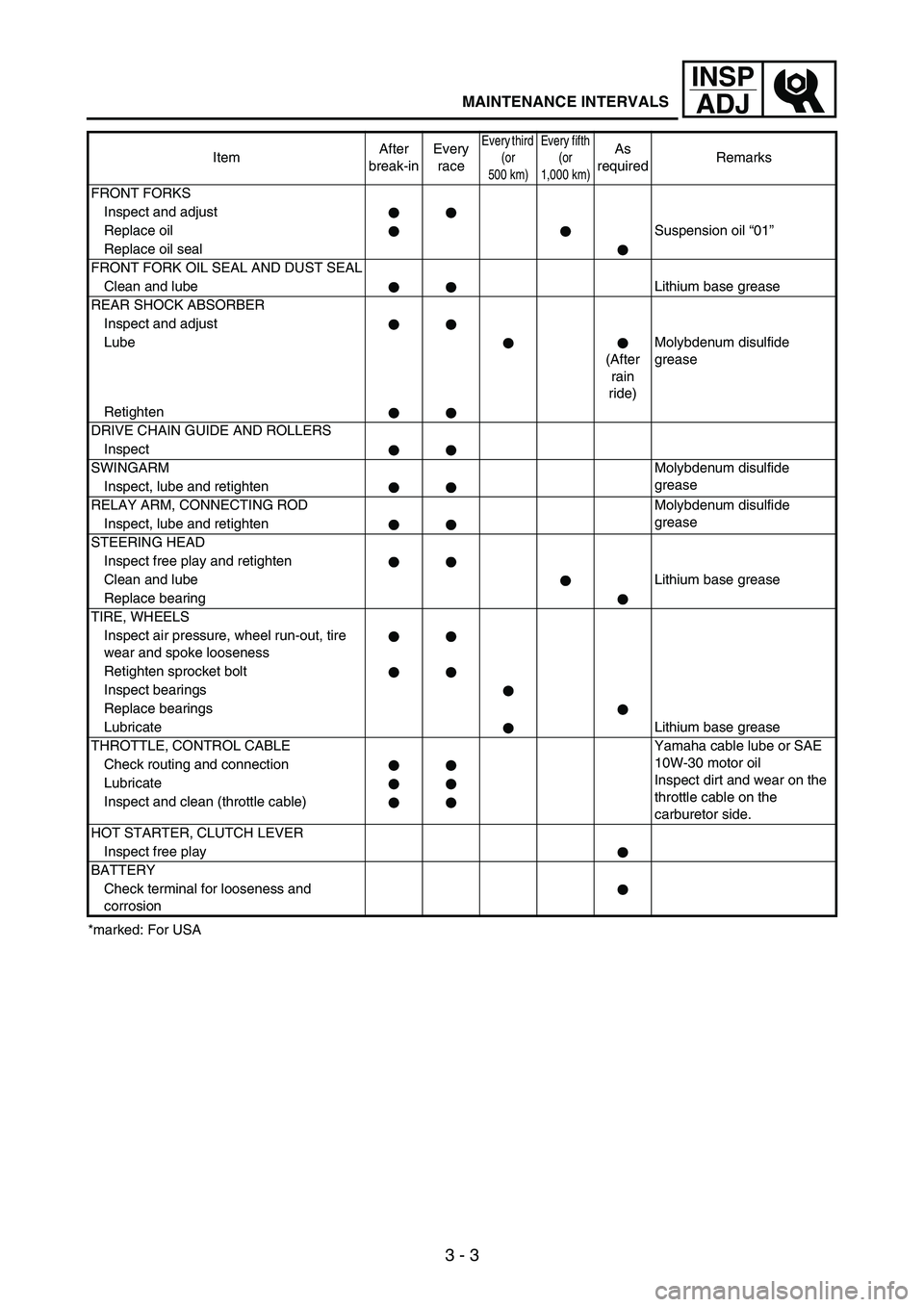
3 - 3
INSP
ADJ
MAINTENANCE INTERVALS
*marked: For USAFRONT FORKS
Inspect and adjust
Replace oilSuspension oil “01”
Replace oil seal
FRONT FORK OIL SEAL AND DUST SEAL
Clean and lubeLithium base grease
REAR SHOCK ABSORBER
Inspect and adjust
Lube
(After
rain
ride)Molybdenum disulfide
grease
Retighten
DRIVE CHAIN GUIDE AND ROLLERS
Inspect
SWINGARMMolybdenum disulfide
grease
Inspect, lube and retighten
RELAY ARM, CONNECTING ROD Molybdenum disulfide
grease
Inspect, lube and retighten
STEERING HEAD
Inspect free play and retighten
Clean and lubeLithium base grease
Replace bearing
TIRE, WHEELS
Inspect air pressure, wheel run-out, tire
wear and spoke looseness
Retighten sprocket bolt
Inspect bearings
Replace bearings
LubricateLithium base grease
THROTTLE, CONTROL CABLE Yamaha cable lube or SAE
10W-30 motor oil
Inspect dirt and wear on the
throttle cable on the
carburetor side. Check routing and connection
Lubricate
Inspect and clean (throttle cable)
HOT STARTER, CLUTCH LEVER
Inspect free play
BATTERY
Check terminal for looseness and
corrosionItemAfter
break-inEvery
race
Every third
(or
500 km)Every fifth
(or
1,000 km)As
requiredRemarks
Page 302 of 860
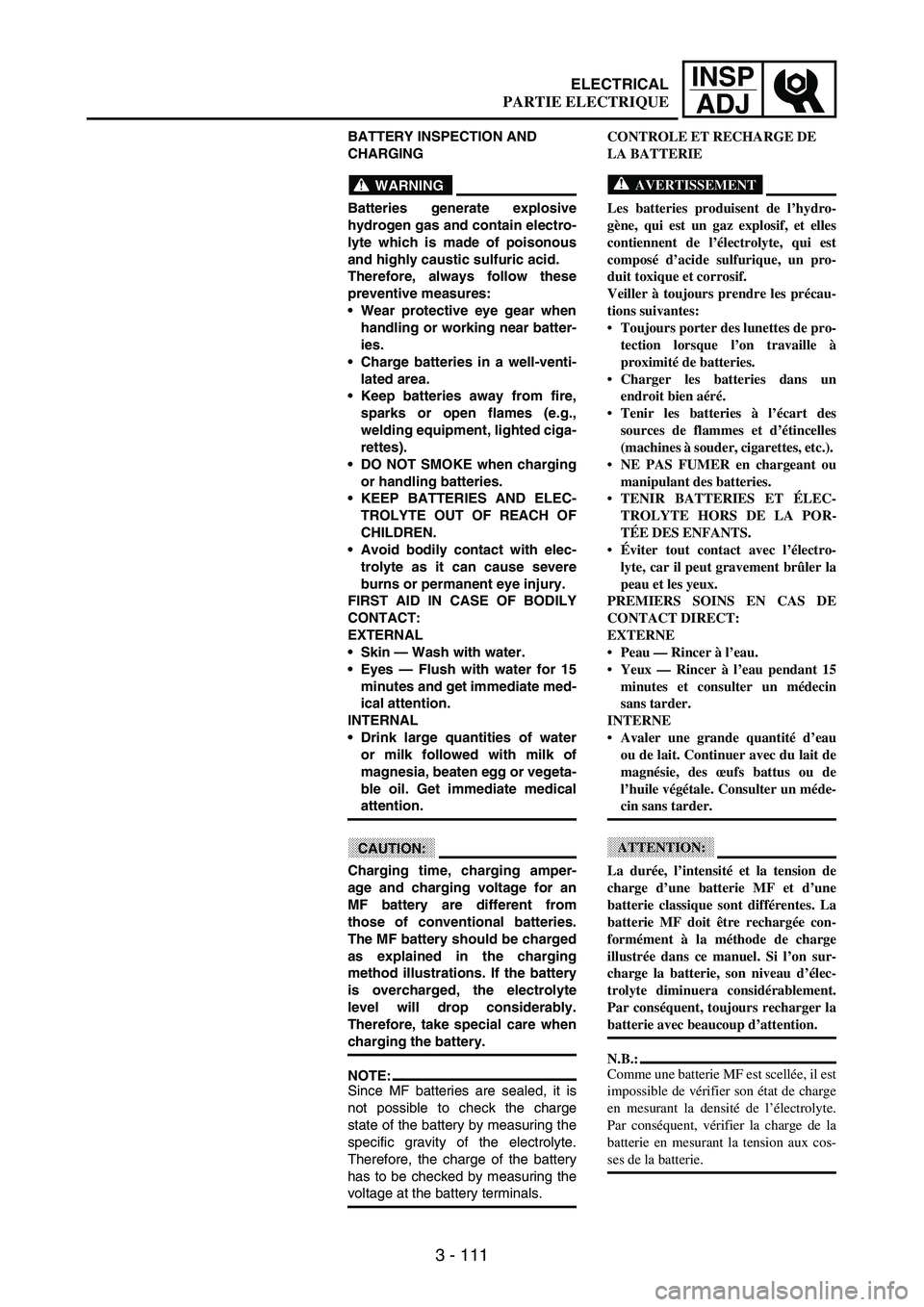
3 - 111
INSP
ADJ
BATTERY INSPECTION AND
CHARGING
WARNING
Batteries generate explosive
hydrogen gas and contain electro-
lyte which is made of poisonous
and highly caustic sulfuric acid.
Therefore, always follow these
preventive measures:
Wear protective eye gear when
handling or working near batter-
ies.
Charge batteries in a well-venti-
lated area.
Keep batteries away from fire,
sparks or open flames (e.g.,
welding equipment, lighted ciga-
rettes).
DO NOT SMOKE when charging
or handling batteries.
KEEP BATTERIES AND ELEC-
TROLYTE OUT OF REACH OF
CHILDREN.
Avoid bodily contact with elec-
trolyte as it can cause severe
burns or permanent eye injury.
FIRST AID IN CASE OF BODILY
CONTACT:
EXTERNAL
Skin — Wash with water.
Eyes — Flush with water for 15
minutes and get immediate med-
ical attention.
INTERNAL
Drink large quantities of water
or milk followed with milk of
magnesia, beaten egg or vegeta-
ble oil. Get immediate medical
attention.
CAUTION:
Charging time, charging amper-
age and charging voltage for an
MF battery are different from
those of conventional batteries.
The MF battery should be charged
as explained in the charging
method illustrations. If the battery
is overcharged, the electrolyte
level will drop considerably.
Therefore, take special care when
charging the battery.
NOTE:Since MF batteries are sealed, it is
not possible to check the charge
state of the battery by measuring the
specific gravity of the electrolyte.
Therefore, the charge of the battery
has to be checked by measuring the
voltage at the battery terminals. CONTROLE ET RECHARGE DE
LA BATTERIE
AVERTISSEMENT
Les batteries produisent de l’hydro-
gène, qui est un gaz explosif, et elles
contiennent de l’électrolyte, qui est
composé d’acide sulfurique, un pro-
duit toxique et corrosif.
Veiller à toujours prendre les précau-
tions suivantes:
Toujours porter des lunettes de pro-
tection lorsque l’on travaille à
proximité de batteries.
Charger les batteries dans un
endroit bien aéré.
Tenir les batteries à l’écart des
sources de flammes et d’étincelles
(machines à souder, cigarettes, etc.).
NE PAS FUMER en chargeant ou
manipulant des batteries.
TENIR BATTERIES ET ÉLEC-
TROLYTE HORS DE LA POR-
TÉE DES ENFANTS.
Éviter tout contact avec l’électro-
lyte, car il peut gravement brûler la
peau et les yeux.
PREMIERS SOINS EN CAS DE
CONTACT DIRECT:
EXTERNE
Peau — Rincer à l’eau.
Yeux — Rincer à l’eau pendant 15
minutes et consulter un médecin
sans tarder.
INTERNE
Avaler une grande quantité d’eau
ou de lait. Continuer avec du lait de
magnésie, des œufs battus ou de
l’huile végétale. Consulter un méde-
cin sans tarder.
ATTENTION:
La durée, l’intensité et la tension de
charge d’une batterie MF et d’une
batterie classique sont différentes. La
batterie MF doit être rechargée con-
formément à la méthode de charge
illustrée dans ce manuel. Si l’on sur-
charge la batterie, son niveau d’élec-
trolyte diminuera considérablement.
Par conséquent, toujours recharger la
batterie avec beaucoup d’attention.
N.B.:
Comme une batterie MF est scellée, il est
impossible de vérifier son état de charge
en mesurant la densité de l’électrolyte.
Par conséquent, vérifier la charge de la
batterie en mesurant la tension aux cos-
ses de la batterie.
ELECTRICAL
PARTIE ELECTRIQUE
Page 304 of 860
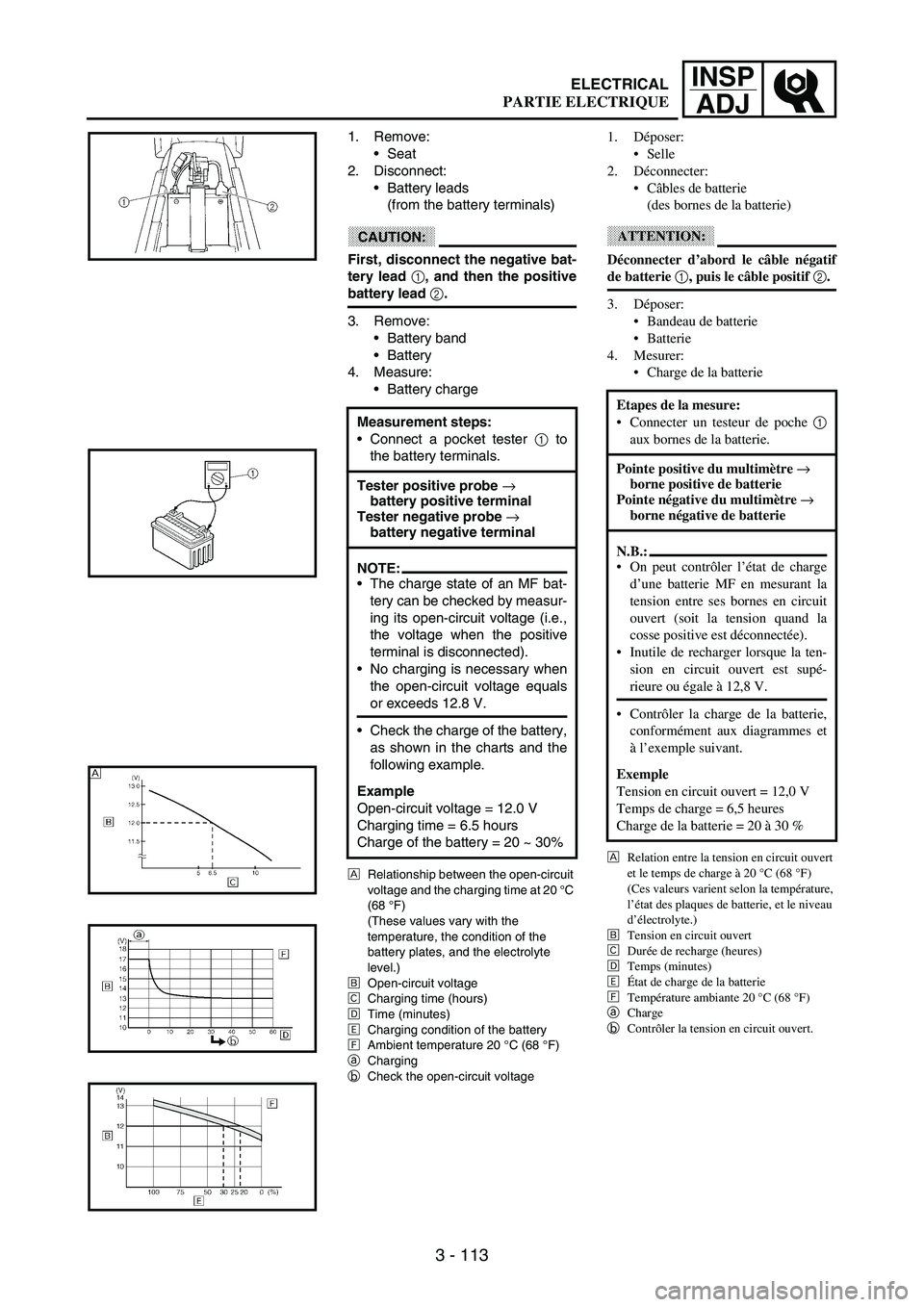
3 - 113
INSP
ADJ
1. Remove:
Seat
2. Disconnect:
Battery leads
(from the battery terminals)
CAUTION:
First, disconnect the negative bat-
tery lead 1, and then the positive
battery lead 2.
3. Remove:
Battery band
Battery
4. Measure:
Battery charge
ÈRelationship between the open-circuit
voltage and the charging time at 20 °C
(68 °F)
(These values vary with the
temperature, the condition of the
battery plates, and the electrolyte
level.)
ÉOpen-circuit voltage
ÊCharging time (hours)
ËTime (minutes)
ÌCharging condition of the battery
ÍAmbient temperature 20 °C (68 °F)
aCharging
bCheck the open-circuit voltage
Measurement steps:
Connect a pocket tester
1 to
the battery terminals.
Tester positive probe →
battery positive terminal
Tester negative probe →
battery negative terminal
NOTE:The charge state of an MF bat-
tery can be checked by measur-
ing its open-circuit voltage (i.e.,
the voltage when the positive
terminal is disconnected).
No charging is necessary when
the open-circuit voltage equals
or exceeds 12.8 V.
Check the charge of the battery,
as shown in the charts and the
following example.
Example
Open-circuit voltage = 12.0 V
Charging time = 6.5 hours
Charge of the battery = 20 ~ 30%
È
1. Déposer:
Selle
2. Déconnecter:
Câbles de batterie
(des bornes de la batterie)
ATTENTION:
Déconnecter d’abord le câble négatif
de batterie 1, puis le câble positif 2.
3. Déposer:
Bandeau de batterie
Batterie
4. Mesurer:
Charge de la batterie
È
Relation entre la tension en circuit ouvert
et le temps de charge à 20 °C (68 °F)
(Ces valeurs varient selon la température,
l’état des plaques de batterie, et le niveau
d’électrolyte.)
É
Tension en circuit ouvert
Ê
Durée de recharge (heures)
Ë
Temps (minutes)
Ì
État de charge de la batterie
Í
Température ambiante 20 °C (68 °F)
a
Charge
b
Contrôler la tension en circuit ouvert.
Etapes de la mesure:
Connecter un testeur de poche 1
aux bornes de la batterie.
Pointe positive du multimètre →
borne positive de batterie
Pointe négative du multimètre →
borne négative de batterie
N.B.:
On peut contrôler l’état de charge
d’une batterie MF en mesurant la
tension entre ses bornes en circuit
ouvert (soit la tension quand la
cosse positive est déconnectée).
Inutile de recharger lorsque la ten-
sion en circuit ouvert est supé-
rieure ou égale à 12,8 V.
Contrôler la charge de la batterie,
conformément aux diagrammes et
à l’exemple suivant.
Exemple
Tension en circuit ouvert = 12,0 V
Temps de charge = 6,5 heures
Charge de la batterie = 20 à 30 %
ELECTRICAL
PARTIE ELECTRIQUE
Page 306 of 860
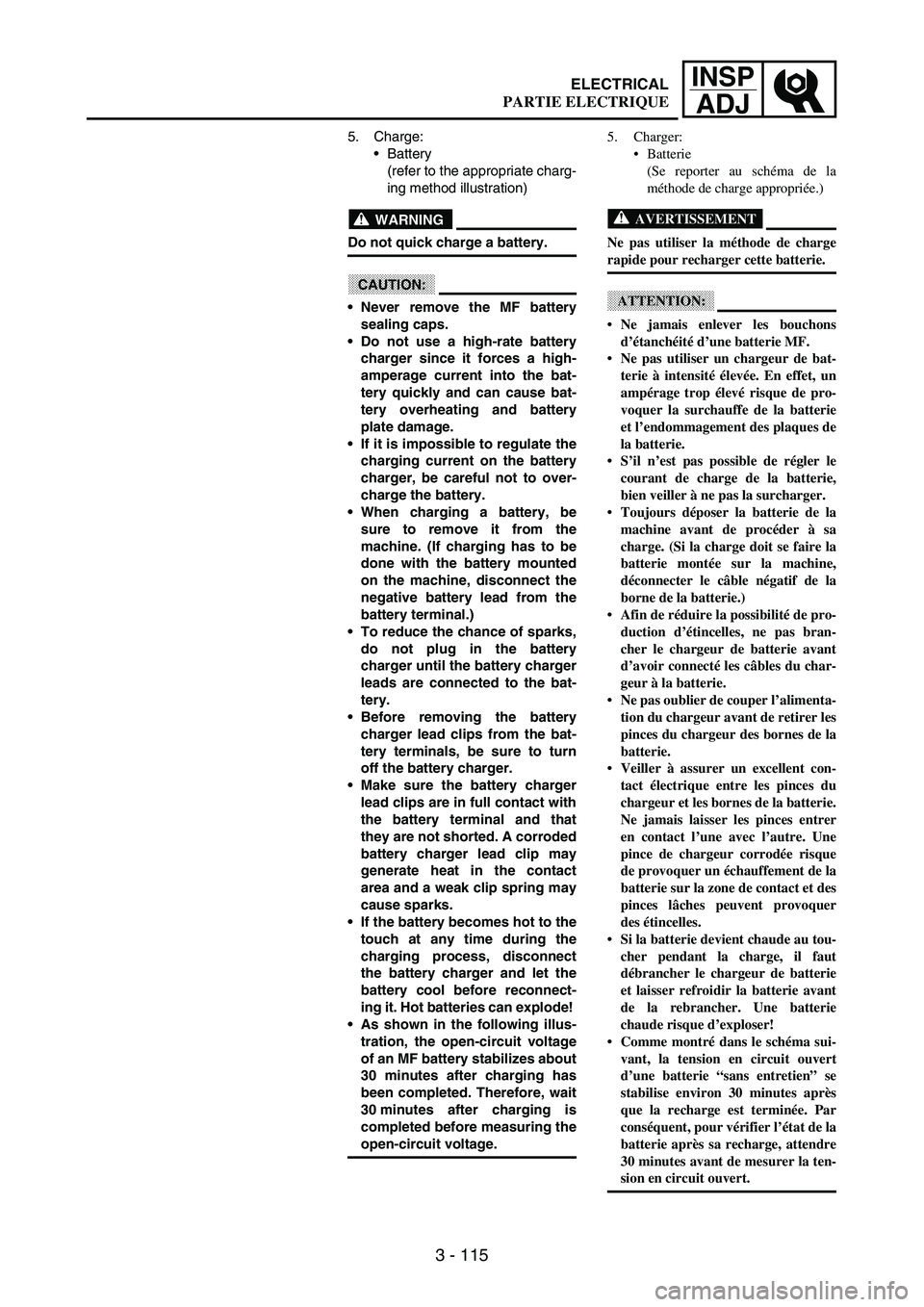
3 - 115
INSP
ADJ
5. Charge:
Battery
(refer to the appropriate charg-
ing method illustration)
WARNING
Do not quick charge a battery.
CAUTION:
Never remove the MF battery
sealing caps.
Do not use a high-rate battery
charger since it forces a high-
amperage current into the bat-
tery quickly and can cause bat-
tery overheating and battery
plate damage.
If it is impossible to regulate the
charging current on the battery
charger, be careful not to over-
charge the battery.
When charging a battery, be
sure to remove it from the
machine. (If charging has to be
done with the battery mounted
on the machine, disconnect the
negative battery lead from the
battery terminal.)
To reduce the chance of sparks,
do not plug in the battery
charger until the battery charger
leads are connected to the bat-
tery.
Before removing the battery
charger lead clips from the bat-
tery terminals, be sure to turn
off the battery charger.
Make sure the battery charger
lead clips are in full contact with
the battery terminal and that
they are not shorted. A corroded
battery charger lead clip may
generate heat in the contact
area and a weak clip spring may
cause sparks.
If the battery becomes hot to the
touch at any time during the
charging process, disconnect
the battery charger and let the
battery cool before reconnect-
ing it. Hot batteries can explode!
As shown in the following illus-
tration, the open-circuit voltage
of an MF battery stabilizes about
30 minutes after charging has
been completed. Therefore, wait
30 minutes after charging is
completed before measuring the
open-circuit voltage. 5. Charger:
Batterie
(Se reporter au schéma de la
méthode de charge appropriée.)
AVERTISSEMENT
Ne pas utiliser la méthode de charge
rapide pour recharger cette batterie.
ATTENTION:
Ne jamais enlever les bouchons
d’étanchéité d’une batterie MF.
Ne pas utiliser un chargeur de bat-
terie à intensité élevée. En effet, un
ampérage trop élevé risque de pro-
voquer la surchauffe de la batterie
et l’endommagement des plaques de
la batterie.
S’il n’est pas possible de régler le
courant de charge de la batterie,
bien veiller à ne pas la surcharger.
Toujours déposer la batterie de la
machine avant de procéder à sa
charge. (Si la charge doit se faire la
batterie montée sur la machine,
déconnecter le câble négatif de la
borne de la batterie.)
Afin de réduire la possibilité de pro-
duction d’étincelles, ne pas bran-
cher le chargeur de batterie avant
d’avoir connecté les câbles du char-
geur à la batterie.
Ne pas oublier de couper l’alimenta-
tion du chargeur avant de retirer les
pinces du chargeur des bornes de la
batterie.
Veiller à assurer un excellent con-
tact électrique entre les pinces du
chargeur et les bornes de la batterie.
Ne jamais laisser les pinces entrer
en contact l’une avec l’autre. Une
pince de chargeur corrodée risque
de provoquer un échauffement de la
batterie sur la zone de contact et des
pinces lâches peuvent provoquer
des étincelles.
Si la batterie devient chaude au tou-
cher pendant la charge, il faut
débrancher le chargeur de batterie
et laisser refroidir la batterie avant
de la rebrancher. Une batterie
chaude risque d’exploser!
Comme montré dans le schéma sui-
vant, la tension en circuit ouvert
d’une batterie “sans entretien” se
stabilise environ 30 minutes après
que la recharge est terminée. Par
conséquent, pour vérifier l’état de la
batterie après sa recharge, attendre
30 minutes avant de mesurer la ten-
sion en circuit ouvert.
ELECTRICAL
PARTIE ELECTRIQUE